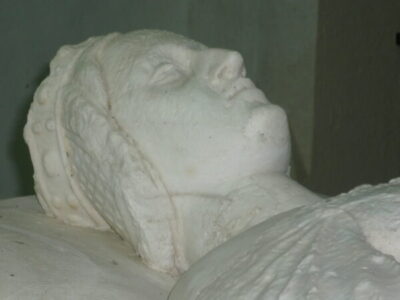
Obscure Borgia Related Places: (1) The Castle of la Motte-Feuilly
- Posted by : Sophie Swerts Knudsen
- 2 January 2022
I feel so blessed that I have experienced many venues related to the Borgias; Rome, the Vatican, Cesena, Senigallia, Milan, Forli, Imola, Spoleto, Ferarra and so many other significant venues where I more than eagerly feasted my eyes on walls, floors, ceilings, beams, frescos, streets, court yards and battlements knowing and feeling, and yes, truly understanding that there in front of my eyes, centuries ago, history actually unfolded itself.
There is, however, a list of marvelous Borgia related places in Italy, France and Spain that I still need to visit for the first time, and where I strongly believe I will also be able to catch the spirit of Cesare and his family. And therefore, I decided to write a series of blog posts on these slightly more obscure places (many of the ones I still need to go and see) that were nevertheless extremely important for the Borgias. Most of these places are less explored mostly because they only played a minor role in their lives for brief periods of time, sometimes merely days. Other less known places are linked to the period after Cesare’s downfall; a period about which very little has been written, and little research has been conducted.
The first place I would like to write about is the Castle of La Motte-Feuilly, located in the region of Berry in France about 80 kilometers from Bourges and 58 kilometers from Issoudun. The name of the castle, La Motte-Feuilly, dates back to the 11th century but the castle itself was built in the 14th and 15th century. Surrounded by a moat, the castle was built on a piece of land that comprised about 5 hectares. Somewhere on the estate of the castle, a pluricentennial yew, that should have been there already during the days of Cesare and Charlotte, is still growing older and older. But more about this yew in a moment.
During Cesare and Charlotte’s honeymoon in the summer months of 1499, they stayed mostly in the little town of Issoudun, more specifically in the White Tower (La Tour Blanche). There is absolutely no doubt that the couple was extremely in love. Cesare wrote his father that he was the happiest man in the world, and Charlotte assured the Pope in her letters that she was extremely happy for her husband. The most significant sign that Cesare truly loved and respected his wife was him giving Charlotte full authority ‘to administer and govern his estates, the county and duchy of Valentinois and Diois, and other his domains, lordships, goods and chattels, in the Kingdom of France as well as in Dauphiné’. He also set his seal on another document that transferred to his wife all his worldly possessions, furniture, jewels, plates etc on the day and hour of his death.[1]
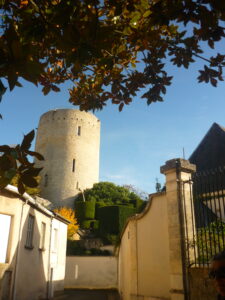
After Cesare’s departure for Italy, Charlotte remained in the White Tower for four years raising her daughter Louise and waiting eagerly for her husband’s return. The homes she created both in Issoudun and La Motte-Feuilly were extremely luxurious because the treasure of gifts Cesare had brought from Italy, and the wealth of the Borgias had turned Charlotte into a lady whose wealth, it was said, exceeded that of the queen of France. Her living quarters were literally stuffed with silver, gold, velvet, damask, pearls, gems and incredibly luxurious trinkets brought from Italy.
It will forever remain a question if Charlotte was aware of the fact that she was a royal ‘hostage’ of Louis XII (to keep Cesare in tow). Pope Alexander VI invited Charlotte to Italy a few times and once he even offered her a large sum of money that should cover all her travel costs. By strict orders, the money, was only to be paid if the travel was a fact; a sign that Alexander VI knew about King Louis XII’s efforts to keep Charlotte in France. Although she was a guest of honor, Cesare’s wife also never made it to Lucrezia’s wedding in Ferarra. Excuses were always found for the Duchess of Valentinois not to cross the border.
The couple surely must have written letters to each other, but even though Charlotte was super meticulous in the preservation of her documents, not a single letter of neither of them has ever been found. This is peculiar, to say the least, and it is often used as a reason to claim that Cesare had ‘forgotten’ his young bride in France. This was certainly not the case. There is a document that proves Cesare sent his wife gifts from Venice in December 1501. The package included: Polished white wax candles, white comfits, fine sweetmeats (zuchari fini), spices of several sorts, preserves in syrup, oranges and lemons, six pipes of Malmsy (wine) and several pieces of cloth (20 braccia – yards).
As the years went by, Charlotte must have given up hope ever to see her dashing husband again. In 1504, already during the turbulent months of Cesare’s downfall, she bought the Château de la Motte Feuilly. Did she do this because she wanted to be further away from the French court that often resided in Blois and that she perhaps now despised? Did she buy the castle because it was a dream she and Cesare had shared during their honeymoon, more than half a decade before? We will never know, unless one day, those letters Charlotte and Cesare wrote to each other suddenly emerge.
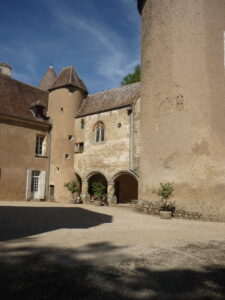
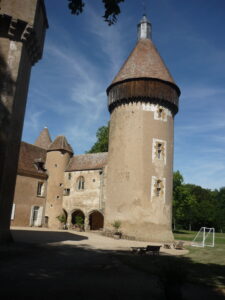
Despite being young, beautiful and extremely wealthy, and even though Queen Anne of Brittany insisted on Charlotte rejoining court life, Charlotte would return to the French court only twice, and only very briefly. The first time was to celebrate the queen’s coronation, and the second time was to plead for her husband Cesare, who had escaped his prison in Spain. Through his wife, he requested the substantial dowry to get back on his feet, and once again, offered his sword to King Louis XII. Louis, however, bluntly refused: he stripped Cesare of all his French titles and lowered the dowry he had promised the couple from 100000 livres tournois to a mere 4000. An incredible humiliation. Charlotte never returned to court afterwards.
When Cesare died in 1507, Charlotte reacted in an extreme way; she closed almost the entire castle and retreated to a few rooms only. Literally everything inside the castle was draped with black material. All the seats, beds, commodes and chests in the apartments were covered with black drapes bearing Cesare’s weapons. She only wore black from that day on. Even her horse was draped in black. A widow at the tender age of 25, she was not planning on ever remarrying again. Merely six years after Cesare’s death, on 11 March 1514, exactly one day before him, she died; according to her biographers, of a broken heart. Charlotte was buried in the chapel at La Motte-Feuilly that she had built for herself.[2]
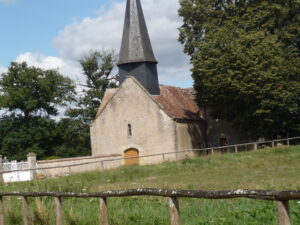
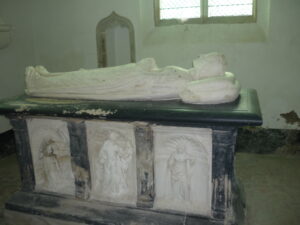
And what does the yew on the estate have to do with Cesare and Charlotte? Nothing concrete really, but since it goes back as far as the time of Charlotte d’Albrèt, I imagine Charlotte sitting under the tree, perhaps together with Cesare when they spent their honeymoon visiting places around Issoudun, or perhaps with little Louise playing in the shadow of the tree.
What is special and slightly mysterious about this yew is that is seems to emerge out of a little building made of small rocks. The rocks measure about 15 meters in circumference, which is quite substantial. Historians believe that the pile of stones was carefully built around the foot of the tree. The question of course is why? The yew of La Motte Feuilly is estimated between 600 and 800 years old, and some claim it to be more than a thousand years old. Legend even says that Joan of Arc sat under the tree. I believe that, if Cesare and Charlotte walked on the estate of La Motte-Feuilly, they must have sat under that yew tree’s young foliage, wondering perhaps where those odd stones came from.
Or where they added afterwards? And who added them?
And where are those letters written by the young married couple?????
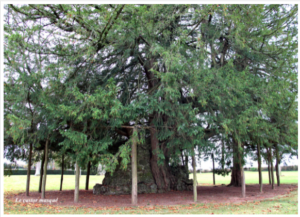
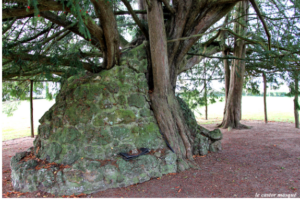
Many thanks to the following sources:
https://treesforlife.org.uk/into-the-forest/trees-plants-animals/trees/yew/
https://en.wikipedia.org/wiki/Taxus_baccata
https://www.berryprovince.com/patrimoine-culturel/le-chateau-de-la-motte-feuilly-la-motte-feuilly/
https://en.wikipedia.org/wiki/Charlotte_of_Albret
https://www.leberry.fr/henrichemont-18250/actualites/borgia-et-son-idylle-a-issoudun_12399224/
Une grande ‘merci’ a Gérard Mallein pour tous les fotos de la Tour Blanche et du Château de la Motte-Feuilly!
Pictures of the yew were borrowed from: http://lestetardsarboricoles.fr/wordpress/2016/11/12/letrange-if-du-chateau-de-la-motte-feuilly-indre/
[1] Miron, The Derelict Duchess.
[2] Schlumberger, Charlotte d’Albret, Femme de César Borgia et le Chateau de la La Motte-Feuilly.
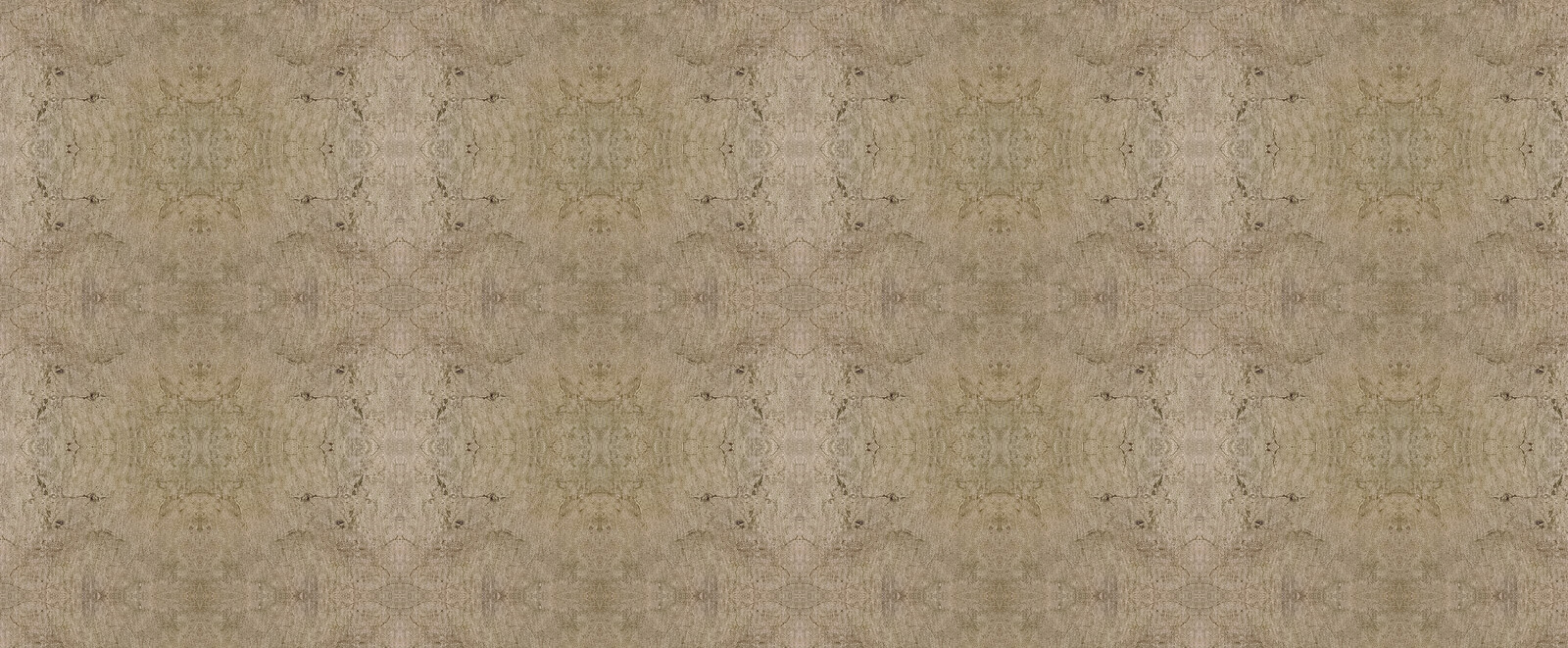

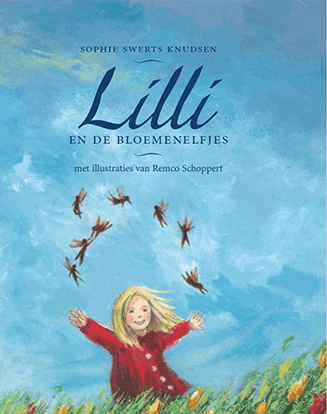

Thank you so much for this post. I, too, desire to visit La Motte Feuilly. I am excited to read your blogs about the more obscure places related to the Borgia.
Thank you, Jackie! The next story will be about Cesena….
I enjoyed this post so very much…thank you….it gives me a little window into the life of Charlotte …Cesare must of truly loved her….you can imagine her sorrow of being kept away from him…
Thanks, Arlene! Lovely to hear. <3
They were so beautiful
Got to thinking maybe Charlotte buried all those letters under that tree…wonder if they could X-ray the area to not disturb the tree to see if it hides anything…there must of been letters in Cesare’s possession from Charlotte or were they destroyed by Julius II in his quest to purge all thing Borgia from the world…
Well, the thought crossed my mind as well. It would be the perfect place to hide their letters – such a ‘sacred’ place. In any case, those letters have either been destroyed by some Borgia hater, or perhaps they are still lying somewhere collecting dust in a museum. Or, maybe, just maybe, they are somewhere on the estate of la Motte-Feuilly. 🙂
Finally found a site with more info on the Borgias, i have been fascinated by the family ever since i heard about them, went to Rome in september, visited castel sant angelo and the vatican and unsuccesfully tried to find Rodrigo’s tombe, going back in april. I have read books about them and now finally blogs of someone who is not biased against them. Thank you and keep it up!
Dear Kelly – thanks so much for your nice words. I can tell you precisely where Rodrigo’s tomb is, so don’t hesitate to ask when you’re returning to Rome. 🙂 I have not written any blogs for a while because I have been busy with my book on Cesare Borgia, but I am hoping to resume my blog writing very soon! Sophie
When Stephanie of Chateau la Lande visted this castle she mention that this family of borgias had connection to history of neighbors of La Lande. Many years back, One of her neighbors was murdered. and there was marriage of the widow. I cant find the information about the connection to Borgia. and I want to know more about this Charlotte. from where?. Laland in crozon indre.
Hi! Thank you for your reaction on my post! 🙂 In my search for material for my book on Cesare Borgia, I found very little has been written on Charlotte d’Albrèt. In 1913, Gustave Schlumberger wrote ‘Charlotte d’Albret, Femme de César Borgia et le Chateau de la La Motte-Feuilly’ and, in 1912, E.L. Miron wrote ‘The Derelict Duchess, a study of the life and times of Charlotte d’Albret, Duchess de Valentinois, Wife of Cesare Borgia’. Both books are also not exactly based on academic research. 🙂 However, you may find a little snippet about her in books about her brother ‘Jean, King of Navarre’ or about her father ‘Alain d’Albrèt’. I hope you find some good information! Sophie 🙂